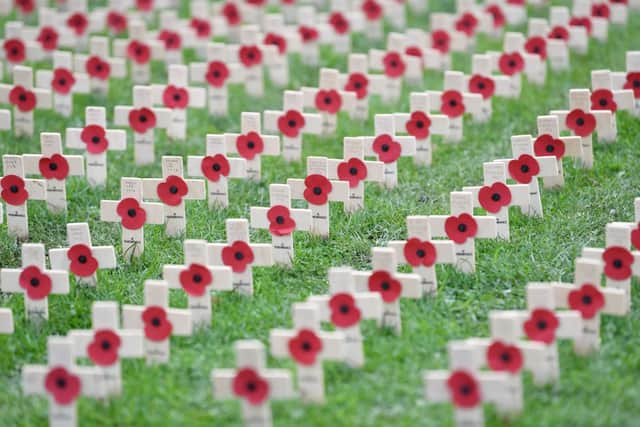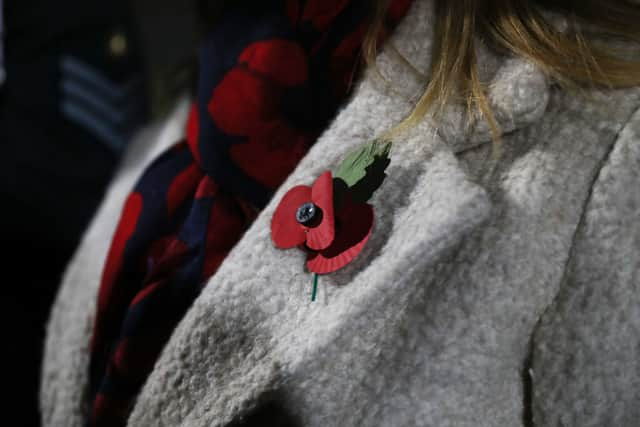Why do we wear poppies? Meaning of white, purple, silver, blue and red Remembrance Day poppy badge explained
This article contains affiliate links. We may earn a small commission on items purchased through this article, but that does not affect our editorial judgement.
and live on Freeview channel 276
With November now in full swing, you’ll likely start to begin seeing poppies cropping up on people’s clothing and in shops as the UK prepares to observe Remembrance Day.
This year will mark 100 years of the poppy as the official symbol of remembrance.
Advertisement
Hide AdAdvertisement
Hide AdThis is everything you need to know - and why you might see others wearing poppies that are purple, black or white instead of red.
What does the poppy represent?
The poppy has become a symbol of remembrance for those who have lost their lives in war, with origins tied to World War One.
The Royal British Legion (RBL) says: “Our red poppy is a symbol of both Remembrance and hope for a peaceful future.”
During WWI, much of the fighting that occurred took place in Western Europe, where the countryside was repeatedly bombed and fought over. What were once beautiful landscapes turned to dirt, where very little would grow.


Advertisement
Hide AdAdvertisement
Hide AdHowever, red Flanders poppies thrived in the churned up soil, and thousands flourished.
A Canadian doctor, Lieutenant Colonel John McCrae, who had recently lost a friend in Ypres, was moved by the sight of the poppies and wrote his poem In Flanders Fields in 1915.
McCrae’s poem went on to inspire American humanitarian Moina Michael, who campaigned to make the poppy a symbol of remembrance for those who had died in the war when she, in 1918, after she wrote her poem We Shall Keep the Faith.
In We Shall Keep the Faith, Michael wrote: “And now the Torch and Poppy Red, we wear in honor of our dead.”
Advertisement
Hide AdAdvertisement
Hide AdWhile she aimed to make the poppy an official symbol across the United States, others did the same in Canada, Australia and the UK.


The first artificial poppies were sold in the UK in 1921, by Anna Guérin, a French woman who persuaded Earl Haig, the founder of the RBL, to adopt the poppy as its emblem.
The RBL, which itself formed in 1921, ordered nine million poppies, and sold them on 11 November that year.
According to the RBL, the first Poppy Appeal sold out “almost immediately” and “raised over £106,000 to help veterans with housing and jobs”.
You can buy poppies online from the RBL shop.
What do the different colours of poppy mean?
Advertisement
Hide AdAdvertisement
Hide AdWhile the most common colour of poppy you’ll see people wearing is red, to commemorate those who sacrificed their lives in WWI, and the conflicts that followed, chances are that you’ll see some variations on the colours of poppies being worn.
The purple poppy is to remember the animals that have been victims of war, particularly the horses that were killed or injured during WWI. Donations to the Purple Poppy Appeal, organised by the War Horse Memorial, go to charities such as the World Horse Welfare.


The black poppy is associated with the commemoration of Black, African and Caribbean communities’ contributions to the war effort.
The white poppy, from the charity Peace Pledge Union, represents “remembrance for all victims of war, a commitment to peace and a challenge to attempts to glamorise or celebrate war”.
Advertisement
Hide AdAdvertisement
Hide AdYou may also see other poppies in different colours, like blue, but these colours don’t hold any significant meaning.
A message from the editor: Thank you for reading. NationalWorld is a new national news brand, produced by a team of journalists, editors, video producers and designers who live and work across the UK. Find out more about who’s who in the team, and our editorial values. We want to start a community among our readers, so please follow us on Facebook, Twitter and Instagram, and keep the conversation going. You can also sign up to our newsletters and get a curated selection of our best reads to your inbox every day.
Comment Guidelines
National World encourages reader discussion on our stories. User feedback, insights and back-and-forth exchanges add a rich layer of context to reporting. Please review our Community Guidelines before commenting.